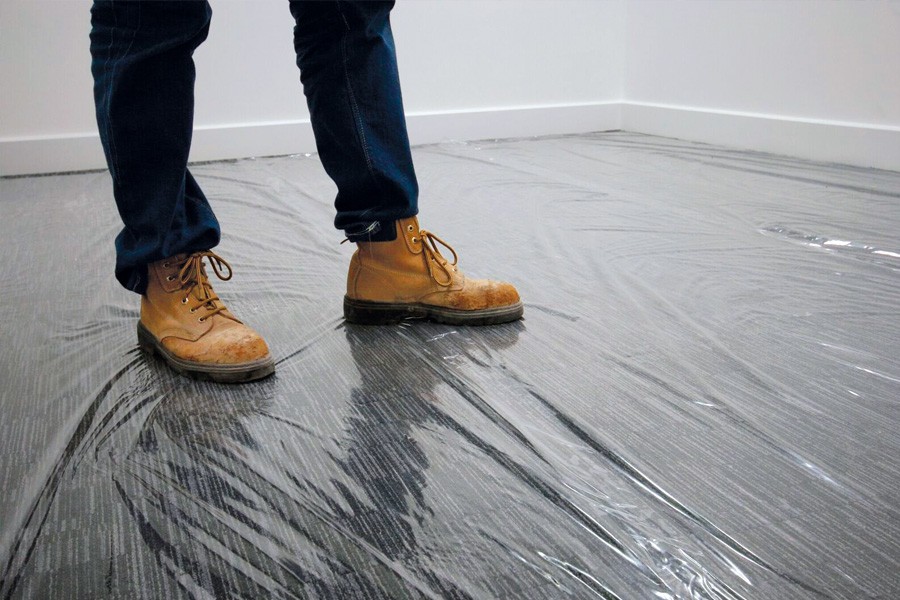Protection of interior floor finishes is often required on both new build and refurbishment projects. Fast track programmes often include floorcoverings installed prior to the completion of work by other trades and, to reduce the risk of damage proper protection materials should be considered.
Levelling screeds and directly finished bases covered by Part 1 of BS 8204 are not designed as wearing surfaces, therefore their surfaces should be given adequate protection against damage or wear during subsequent building operations and until the flooring is laid. Note that, where cement and sand levelling screeds have dried sufficiently after curing, it can be advantageous for the temporary protection to be relatively impervious. This will minimise the likelihood of differential moisture levels developing between the top and bottom of the screed before the flooring is installed, thus minimising the risk of lipping and curling at joints or cracks in the screed, as described in BRE Current Paper 94/74. Breathable protection is available which avoids trapping in moisture vapour should you need to protect uncured floors immediately.
Flame Retardant Protection
Loss Prevention Standard LPS1207 issued by the Loss Prevention Certification Board, part of BRE Certification, a sister company to the Building Research Establishment, relates to the requirements for protective covering materials on construction sites. Any temporary protection which purports to comply with LPS1207 must be suitably marked and display the name and identification of the supplier.
Warrington Exova TS61 is also a recognised flame retardant standard and accepted on UK construction sites.
Choosing the correct product
There are many forms of temporary protection — a product fit-for-purpose should be selected after considering the following points:
- The surface requiring protection
- The site conditions and site traffic
- The length of time a surface requires protection prior to handover
- The level of protection required
Advice on selection of the appropriate material is available from suppliers.
Smooth Floors
For smooth floors (vinyl, resilient floors, screeds, marble, timber, laminates, etc) a product providing impact protection is needed. Products to consider include twin-wall/twin-fluted polypropylene board and hardboard.
Twin-wall/twin-fluted polypropylene board is supplied in sheet form, normally 1.2m × 2.5m, the board’s twin-wall composition offers impact protection to hard floors. Available in various grades, twin-wall board is ideally suited to hard floors. Hardboard is also supplied in sheet form, with a large variety of sheet sizes being available, from 1.22m × 0.61m up to 3.05m × 1.22m. Hardboard also offers protection against scuffs, scratches and impact. It is advisable to check to see if hardboard protection needs to be flame retardant.
Both polypropylene board and hardboard can be recycled. Advice on selection of the appropriate material is available from suppliers.
For heavier traffic sites or sites requiring protection for a longer term, please consider heavier grade protection. Hardboard or heavier duty fluted polypropylene board may be considered. Please consult your protection supplier.
Soft Floors
For soft floors, e.g., carpets, etc., impact protection is not an issue. For cut-pile carpets, an adhesive backed “tacky back” polythene can be used. This product is simply rolled out and bonds directly to the carpet. The tacky back will hold the product in place during the programme of works. After use, the material simply peels clean, leaving no residue.
For loop and cut pile carpets a loose fitting membrane can be used, either a polypropylene or polyethylene sheeting. This can then be fixed in place using either tapes, or, for a loop pile carpet using a male Velcro dry-fix method.
Moisture-sensitive Floorcoverings
There may be some risks if moisture-sensitive floorcoverings are protected for prolonged periods with impervious protection material as there is a chance that the floor may “sweat” underneath. This is of particular relevance where there is underfloor heating: If impervious protection is to be used long term over a moisture sensitive floorcovering it is advisable to contact the manufacturers of the floorcovering beforehand. Breathable protection products should be considered.
Fixing methods
Fixing methods for protection must be considered. For smooth and finished floors, a peel-clean adhesive tape must be used. Standard tapes may leave a residue or shadow on the floor. For cut-pile carpets, a higher tack carpet tape should be used. For loop or twist-pile carpets, a Velcro dry-fix method should be used.


